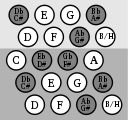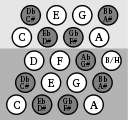.gif)
Bayan (accordion)
Encyclopedia
The bayan is a type of chromatic button accordion
Chromatic button accordion
A chromatic button accordion is a type of button accordion where the melody-side keyboard consists of rows of buttons arranged chromatically. The bass-side keyboard is usually the Stradella system or one of the various free-bass systems. Included among chromatic button accordions are the Russian...
developed in Russia
Russia
Russia or , officially known as both Russia and the Russian Federation , is a country in northern Eurasia. It is a federal semi-presidential republic, comprising 83 federal subjects...
in the early 20th century and named after 11th-century bard Boyan
Boyan (bard)
Boyan is the name of a bard who was mentioned in the Rus' epic The Lay of Igor's Campaign as being active at the court of Yaroslav the Wise. He is apostrophized as Volos's grandson in the opening lines of The Lay...
.
Characteristics


- Reeds are broader and rectangularRectangleIn Euclidean plane geometry, a rectangle is any quadrilateral with four right angles. The term "oblong" is occasionally used to refer to a non-square rectangle...
(rather than trapezoidTrapezoidIn Euclidean geometry, a convex quadrilateral with one pair of parallel sides is referred to as a trapezoid in American English and as a trapezium in English outside North America. A trapezoid with vertices ABCD is denoted...
al). - Reeds are often attached in large groups to a common plate (rather than in pairs); the plates are screwScrewA screw, or bolt, is a type of fastener characterized by a helical ridge, known as an external thread or just thread, wrapped around a cylinder. Some screw threads are designed to mate with a complementary thread, known as an internal thread, often in the form of a nut or an object that has the...
ed to the reed block (rather than attached with waxWaxthumb|right|[[Cetyl palmitate]], a typical wax ester.Wax refers to a class of chemical compounds that are plastic near ambient temperatures. Characteristically, they melt above 45 °C to give a low viscosity liquid. Waxes are insoluble in water but soluble in organic, nonpolar solvents...
). - The melodyMelodyA melody , also tune, voice, or line, is a linear succession of musical tones which is perceived as a single entity...
-side keyboardMusical keyboardA musical keyboard is the set of adjacent depressible levers or keys on a musical instrument, particularly the piano. Keyboards typically contain keys for playing the twelve notes of the Western musical scale, with a combination of larger, longer keys and smaller, shorter keys that repeats at the...
is attached near the middle of the body (rather than at the rear). - Reeds are generally not tuned with tremoloTremoloTremolo, or tremolando, is a musical term that describes various trembling effects, falling roughly into two types. The first is a rapid reiteration...
. - RegisterRegister (music)In music, a register is the relative "height" or range of a note, set of pitches or pitch classes, melody, part, instrument or group of instruments...
switches may be operated with the chin on some larger models. - The diminished seventh chord row is shifted, so that the diminished seventh G chord is where one would expect the diminished seventh C chord in the Stradella bass system.
- Converter switches that go from standard preset chords to free bass (individual bass notes) are common on the larger instruments.
- Newer instruments may feature a register, where every tone played actually produces a perfect fifthPerfect fifthIn classical music from Western culture, a fifth is a musical interval encompassing five staff positions , and the perfect fifth is a fifth spanning seven semitones, or in meantone, four diatonic semitones and three chromatic semitones...
.
The differences in internal construction give the bayan a different tone color from Western instruments, and the bass has a much fuller sound. Because of their range and purity of tone, bayans are often the instrument of choice for accordion virtuosi who perform classical and contemporary classical music
Contemporary classical music
Contemporary classical music can be understood as belonging to the period that started in the mid-1970s with the retreat of modernism. However, the term may also be employed in a broader sense to refer to all post-1945 modern musical forms.-Categorization:...
. Two Soviet composers of note who wrote compositions for bayan are Vladislav Zolotaryov
Vladislav Zolotaryov
Vladislav Andreyevich Zolotaryov , was a Soviet composer and bayanist. He graduated from the class of N. A. Lesnoi at the Magadan Secondary School of Music in 1968, and studied composition under the guidance of R. K. Shchedrin , and with T. N. Khrennikov...
and Sofia Gubaidulina
Sofia Gubaidulina
Sofia Asgatovna Gubaidulina, is a Russian composer of half Russian, half Tatar ethnicity.Gubaidulina's music is marked by the use of unusual instrumental combinations...
. Russian Bayan virtuoso Stas Venglevski has premiered contemporary works by Yehuda Yannay
Yehuda Yannay
Yehuda Yannay is an American-Israeli composer, conductor, film maker and performance artist.Yannay moved from Romania to Israel in 1951, where he studied with Alexander Uriya Boskovitch , who influenced him greatly...
, Anthony Galla-Rini
Anthony Galla-Rini
Anthony Galla-Rini was a celebrated American accordionist, arranger, composer, conductor, author, and teacher, and is considered by many to be the first American accordionist to promote the accordion as a "legitimate" concert instrument.-Early life:Galla-Rini was born in Manchester, Connecticut,...
and William Susman
William Susman
William Joseph Susman, born August 29, 1960 in Chicago, is an American composer of concert and film music as well as an accomplished pianist. He belongs to the generation of American composers that came of age in the late twentieth century, received traditional academic training while remaining...
.
Media
Sources
- Cherkasky, L. - Ukrainski narodni muzychni instrumenty // Tekhnika, Kiev, Ukraine, 2003 - 262 pages. ISBN 966-575-111-5

